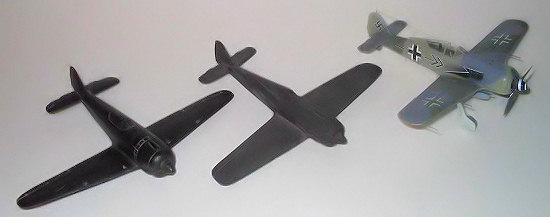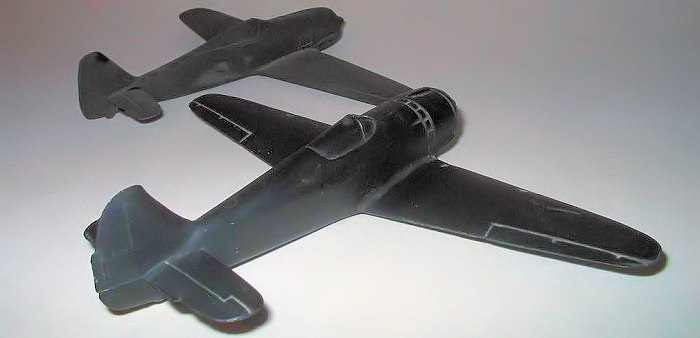
WORLD WAR II VINTAGE 1/72 SCALE FOCKE WULF FW-190A

HISTORY
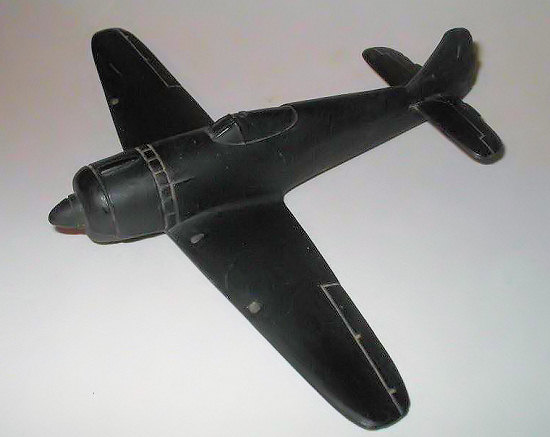 Before World War II, the
British Frog company produced a series of plastic scale models in 1/72 scale.
These have since become collectors’ items, and a few have been reproduced in
recent years. Their quality, at least in the one I have, a Hawker Hind Trainer,
is pretty high even by modern standards. During the war, Frog produced 1/72
scale models in black plastic for the British armed forces, and when the United
States became involved in the war, similar models were produced in this country.
In Germany, recognition models were also built, some of cardboard with flat
fuselages and round tabs to simulate the outline of the airplane when viewed
from various angles.
Before World War II, the
British Frog company produced a series of plastic scale models in 1/72 scale.
These have since become collectors’ items, and a few have been reproduced in
recent years. Their quality, at least in the one I have, a Hawker Hind Trainer,
is pretty high even by modern standards. During the war, Frog produced 1/72
scale models in black plastic for the British armed forces, and when the United
States became involved in the war, similar models were produced in this country.
In Germany, recognition models were also built, some of cardboard with flat
fuselages and round tabs to simulate the outline of the airplane when viewed
from various angles.
A large scale program was initiated early in 1942 to have high school students build models for the military for recognition training. Schools participated in the National School Model Building Program, and by February, 1942, a total of 90 official sets of plans and cardboard templates had been produced by the Navy Bureau of Aeronautics. One of these, the FW-190, is reproduced here. These were printed on card similar to index cards or manila folders, and distributed to schools participating in the program.
Additional model plans were
added later, as more information became available, as some of the early models
were of airplanes that didn’t actually exist, or were so inaccurate in outline
that they were hardly recognizable. These were
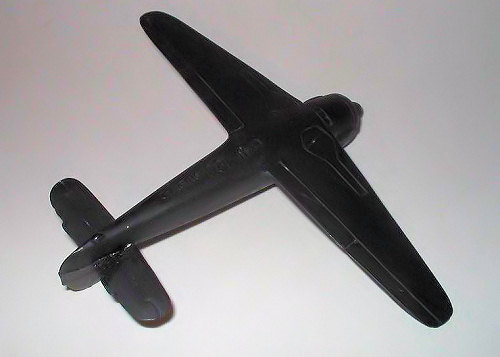 built of pine or other hardwoods
for durability. Later, kit manufacturers, such as Strombecker and Comet,
produced kits for the program. Strombecker pioneered the hardwood pre-formed
model kit in the late thirties, and produced these all during the war, many in
1l/72 scale. I can recall building Strombecker P-40’s, Curtiss SBC’s, and even
B-17’s, while later, they produced a B-17, B-24, B-29 and even a P-61 and P-80
in the same scale, but some of these were postwar issues.
built of pine or other hardwoods
for durability. Later, kit manufacturers, such as Strombecker and Comet,
produced kits for the program. Strombecker pioneered the hardwood pre-formed
model kit in the late thirties, and produced these all during the war, many in
1l/72 scale. I can recall building Strombecker P-40’s, Curtiss SBC’s, and even
B-17’s, while later, they produced a B-17, B-24, B-29 and even a P-61 and P-80
in the same scale, but some of these were postwar issues.
One problem with wartime kits was the fact that balsa wood became unobtainable, and even “block and slab” kits from such firms as Comet and Maircraft used hardwood, making them harder for kids to whittle out.
THE MODELS
I have two recognition models of the Focke Wulf FW-190. The first is an original I received from a friend who knew that I liked FW-190’s. It is dated July, 1942, and is quite inaccurate in outline. The second is a reproduction done by John Nitka, of Tucson, AZ, who recast a later version in resin and painted it black. This represents a later military issue although there is no indication of its date, and is reasonably accurate in outline.
POSTWAR
After the war, these models
became surplus, and were sold by the thousands in Army-Navy surplus stores
throughout the nation. I recall seeing barrels of them in stores, and they were
pretty cheap. Anyone in the military had access to them, and many brought
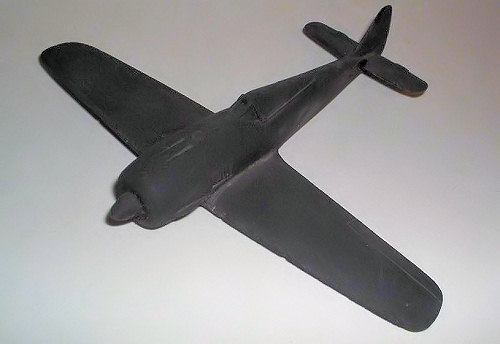 them home. My father, who was
in the Civil Air Patrol during the war, brought home quite a few of them,
including such types as the Cant. Z.1012, Heinkel HE-115, Savoia Marchetti S,79
and S.M. 81, and B-17. I also recall him bringing home a very large box as a
Christmas present. It must have been about 3 by 6 feet, and when we opened it,
it was a complete collection of Army recognition tank models in what must have
been 1/35 scale. They were cast in metal, but that is another story. I wish we
had saved them.
them home. My father, who was
in the Civil Air Patrol during the war, brought home quite a few of them,
including such types as the Cant. Z.1012, Heinkel HE-115, Savoia Marchetti S,79
and S.M. 81, and B-17. I also recall him bringing home a very large box as a
Christmas present. It must have been about 3 by 6 feet, and when we opened it,
it was a complete collection of Army recognition tank models in what must have
been 1/35 scale. They were cast in metal, but that is another story. I wish we
had saved them.
After the War, Polk’s Model Craft Hobbies, of New York City, marketed these “black plastic” models in their store and by mail order, and I recall buying a Japanese Zero (A6M2) and drilling out holes for the landing gear and a prop so I could play with it. I also recall seeing a metal cast Martin PBM “Mariner” recognition model, although I don’t know how many were made of this material. I did know a guy in Tucson who had a collection of I believe about 135 different ID models, and his collection was among the top ten in the country.
RECOGNITION MODELS’ INFLUENCE ON MODERN MODELING
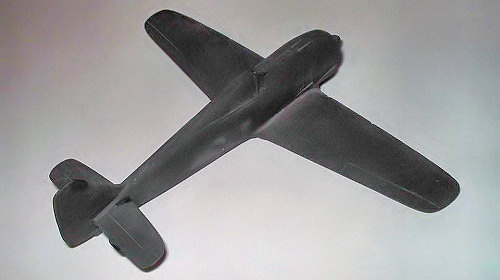 I believe that both in the US
and the UK, the recognition model has had a great deal of influence on
subsequent modeling. First, it introduced scale, where all of the models in a
collection were to a constant scale, and were therefore comparable. Second, it
introduced upgrades, where a more accurate outline resulted in a more accurate
model. Third, it gave the modeler and enthusiast an idea of the wide variety of
aircraft types in existence, possibly stimulating interest in the subject. And
fourth, it established 1/72 scale is the most prolific scale, since more
different types of aircraft have been produced in this scale than any other. So
it is probably true to say that model airplanes did have a part in winning the
war.
I believe that both in the US
and the UK, the recognition model has had a great deal of influence on
subsequent modeling. First, it introduced scale, where all of the models in a
collection were to a constant scale, and were therefore comparable. Second, it
introduced upgrades, where a more accurate outline resulted in a more accurate
model. Third, it gave the modeler and enthusiast an idea of the wide variety of
aircraft types in existence, possibly stimulating interest in the subject. And
fourth, it established 1/72 scale is the most prolific scale, since more
different types of aircraft have been produced in this scale than any other. So
it is probably true to say that model airplanes did have a part in winning the
war.
September 2007
